Britta Marakatt-Labba was born in 1951 to a Swedish Sami family that sewed their own clothes and winter shoes, as was then common. Embroidery is threaded throughout the visual vocabulary of Sapmi, the region of northern Scandinavia that is home to the Sami people – not least in gakti, the traditional costume stitched with ornate designs. It’s hardly surprising, then, that while studying art in Gothenburg in the 1970s, Marakatt-Labba found that textile art was her calling. ‘It suddenly clicked that this was what I wanted to make – that I’m going to work like a painter, but with thread,’ she recalls. ‘I was brought up with these materials and wanted to use them to tell stories about our culture.’
Today, Marakatt-Labba lives in Ovre Soppero, a village of some 200 inhabitants in Lapland, where she creates her narrative embroideries alongside theatre set and costume designs, watercolours, lithographs and illustrations. Her subjects are drawn from Sami history, culture, current affairs and mythology – the latter learnt from her mother, a widow who raised nine children in a family of reindeer herders. (This tradition continues today: Marakatt-Labba’s husband and son are both herders.)
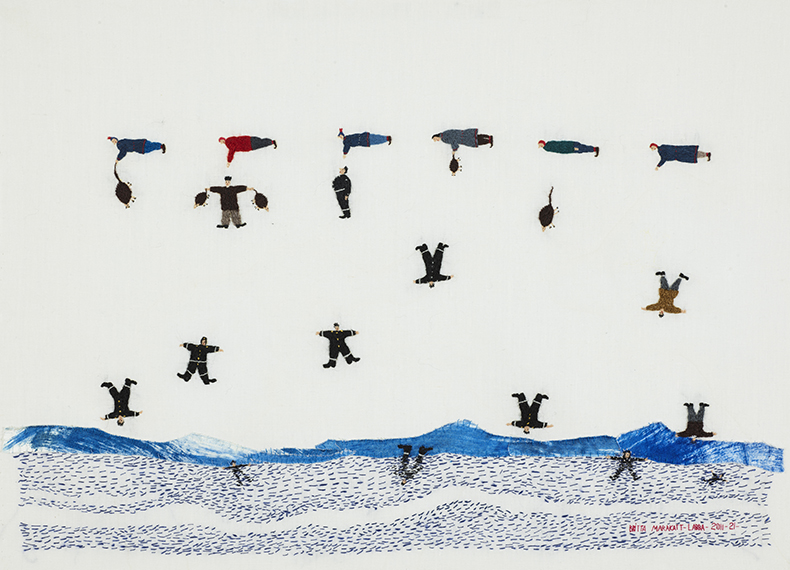
Flying Shamans (2011–21), Britta Marakatt-Labba. Photo: Hans-Olof Utsi; © the artist/BONO
In her textile pieces, figures, animals, buildings and trees are stitched on to a white fabric ground that stands in for the ice and snow of Sapmi. At first sight, these wintery works can appear rather cosy, like pictures from a children’s book or a painting by L.S. Lowry. Look longer, though, and it all becomes more complex. Alongside happier scenes depicting folk tales, ice-fishing and herding are landscapes marred by resource extraction and its aftermath; protestors demonstrating against governments and corporations; ice sheets shattered by a changing climate.
Marakatt-Labba’s decision to use textiles to tell Sami stories may now seem like an obvious choice. However, at the start of her career in the 1970s, it represented a radical departure from artistic norms – both in medium and in message. ‘People didn’t know anything about the Sami, and [fine] art had a much higher status than our traditional handicrafts,’ she says. ‘We had to start from scratch. It’s much easier for young artists today.’ She’s not wrong. Shortly after we speak, the Tate announced a new acquisitions policy designed to increase its holdings of Sami and Inuit art from Northern Europe (at present, it owns just one work by a Sami artist). That public perceptions are changing is thanks, in part, to ground broken by Marakatt-Labba and her peers.
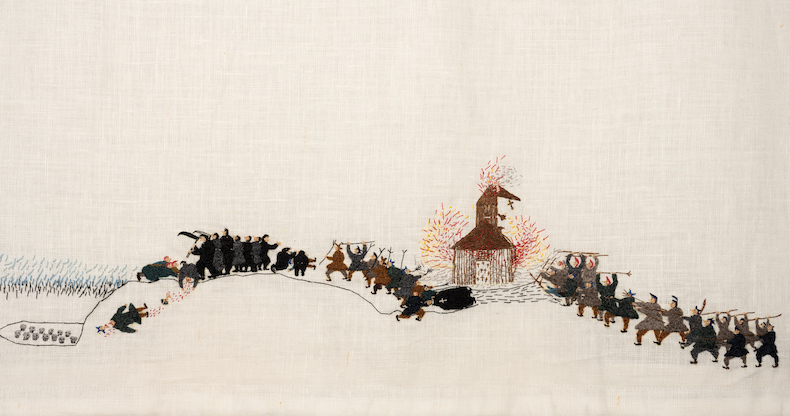
History (detail; 2003–2007), Britta Marakatt-Labba. Photo: Ina Wesenberg/the National Museum, Oslo; © the artist/BONO
In 1978, she co-founded the Maze Group: a collective of artists determined to make work on Sami themes. The group stood against the assimilationist position (the ‘Norwegianisation’) long practised against the Indigenous people of the region. Stakes were high, with artists monitored by Norwegian police on suspicion of ‘extreme political activity’. It’s a world away from the institutional approval Marakatt-Labba has lately received: a retrospective at the National Museum in Oslo (until 25 August). When I enquire about the proudest achievement of her career, she beams – it is this exhibition. ‘I couldn’t even dream about such a thing when we started to work with Sami art.’
A turning point came back in 2017, when Marakatt-Labba’s History (2003–07), a frieze-like work illustrating a great span of Sami history and mythology, was shown at Documenta 14. With this came an upswing in international interest: to many, the 23.5-metre-long embroidery was a revelation. ‘I started from the beginning, when there were only forests – then the animals who belong to this Arctic area, then the stories of the people,’ she says. ‘It took me five years to make.’ History is packed with incident: there are folk legends (including a warning against teasing the Northern Lights, lest you find yourself whisked heavenwards) alongside historical events. A burning church references the Kautokeino uprising of 1852, when a Sami group attacked representatives from the Norwegian authorities. ‘Christians have done a lot of bad things to Sami people,’ she says, her tone factual. In its semi-collapsed state, the blazing church spire recalls the horn-shaped women’s hat (sarvilakki), the wearing of which – like many items of traditional dress – was discouraged by Lutheran priests, who thought it devilish.
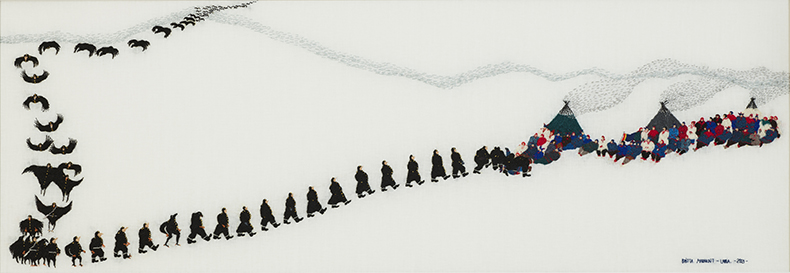
The Crows (2021), Britta Marakatt-Labba. Photo: Hans-Olof Utsi; © the artist/BONO
In The Crows (2021; a version of a work she first made in 1981), the artist revisits a more recent moment of rebellion. In 1980, Marakatt-Labba took part in protests against the construction of a hydroelectric dam on the river Alta that would displace Sami residents and disrupt reindeer migration. (The plot of Disney’s Frozen II is, surprisingly, based partly on this episode.) Hunger-striking activists camped outside the Norwegian parliament and more than 1,000 protestors chained themselves to the building site. Marakatt-Labba was one of 800 people arrested for civil disobedience. In The Crows, policemen sent to scatter protestors are reimagined as carrion-hungry birds, which transform into black-uniformed men as they alight on the ground. The work struck a chord with the public: its untranslated title, Garjjat, has been heard in songs and shouts during recent protests.
Last October, campaigners blocked an Oslo thoroughfare with Sami tents to demand the demolition of illegal wind farms built on Sami pastures. ‘We can’t use the so-called climate transition as a cover for colonialism,’ Greta Thunberg told journalists at the event. There’s a bitter irony in the fact that traditional lifestyles are endangered both by misjudged green infrastructure projects and by climate change itself, as once-predictable weather patterns can no longer be relied on to guide the actions of reindeer herders. In Cracked (2009), Marakatt-Labba reflected on an accident that took place not far from her village, when a herd crossing a frozen river crashed through its unseasonably thin ice.
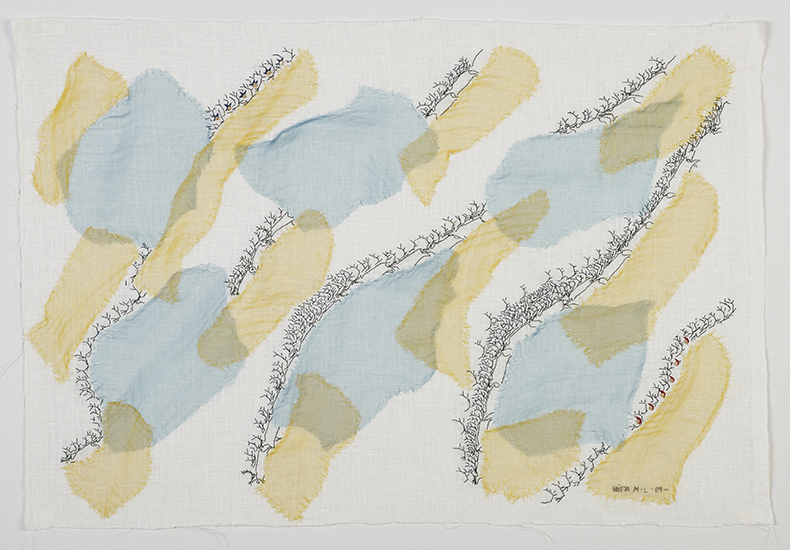
Cracked (2009), Britta Marakatt-Labba. Photo: Hans-Olof Utsi; © the artist/BONO
In Global Warming II (2021), a work that has just been acquired by the National Museum in Stockholm, sheet ice has become shards and blue water. The technique matches the topic: appliquéd fabric fragments take the place of her usual flowing stitches. The composition, a shattered circle, is also significant. ‘I work a lot with circles because in Sami culture we have this idea that everything is circular. There is no start and no end, because life is going round and round.’ This broken circle symbolises the fragmentation of weather patterns and behaviours as much as it does the ice itself. However bleak her subject matter, though, there’s a sense of wholeness in Marakatt-Labba’s work – that stitching can become, symbolically as well as literally, a process of mending.
‘Britta Marakatt-Labba: Moving the Needle’ is at the National Museum in Oslo until 25 August.
Unlimited access from just $16 every 3 months
Subscribe to get unlimited and exclusive access to the top art stories, interviews and exhibition reviews.



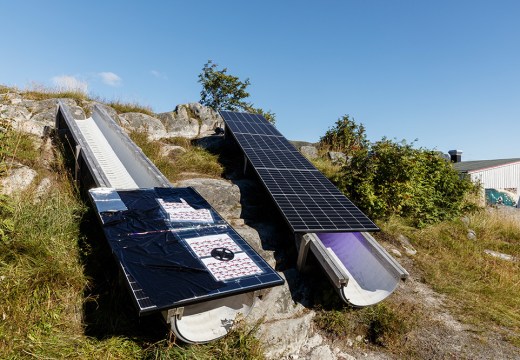
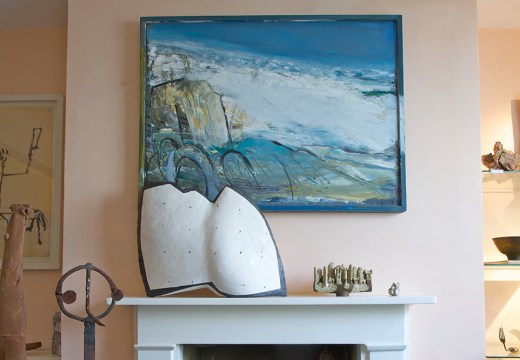









![Masterpiece [Re]discovery 2022. Photo: Ben Fisher Photography, courtesy of Masterpiece London](http://www.apollo-magazine.com/wp-content/uploads/2022/07/MPL2022_4263.jpg)
It’s time for the government of London to return to its rightful home